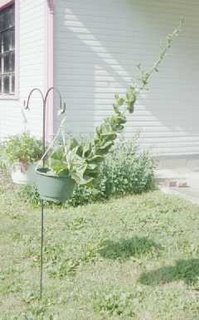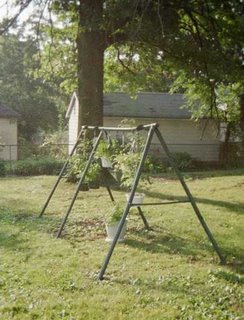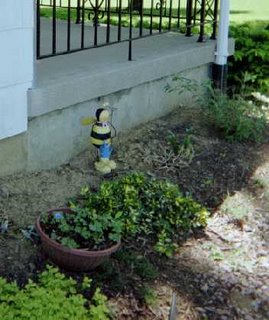
The Portulacas bloomed in the sun and closed up at night. With recent frosts, they're done for the year. (They are annuals, but sometimes they will re-seed for next year below where the pot was hanging.):

My garden journal. I'll recount progress and happenings in the conversion of my one-acre yard from a sparse landscape to an active backyard habitat for wildlife (and me).

Plus, the perennials are on sale...
I also got some little shrubs transplanted from the Summer nursery to their permanent homes. Two forsythia and two smoke bushes. One smoke bush replaced my small hawthorne--after being mowed over then getting quince rust, there wasn't much left to save. (Pix to come later.)
This is the beginning of the bloom. As we move into fall, the tufts will turn pink, then darken to crimson as the season progresses. Even into winter, when the tufts go brown, the sedums still look interesting.


The ones alongside the shed seem to be the healthiest. A bunch of those look set to bloom...maybe together.
These along the fence have been struggling, but the soil is quite thin.

 Chainlink fence has its place, I suppose, but it doesn't do much in the way of screening out problem views. Check out the big propane tank midway up on the right. It's even uglier in real life--a good amount of the paint is chipping off.
Chainlink fence has its place, I suppose, but it doesn't do much in the way of screening out problem views. Check out the big propane tank midway up on the right. It's even uglier in real life--a good amount of the paint is chipping off. Did you know that radicchio gets flowers? Okay, so I shouldn't have let it bolt, but once it started I was curious to see what it would do (it looked rather like something from a SciFi channel promo when it started to go). First it got this weird knob-like thing on top, then it went all spiky, and now it has pretty blue-purple flowers kind of like chicory. Turns out, radicchio is Italian chicory! Saw it on Gourmet Sleuth. Go figure.
Did you know that radicchio gets flowers? Okay, so I shouldn't have let it bolt, but once it started I was curious to see what it would do (it looked rather like something from a SciFi channel promo when it started to go). First it got this weird knob-like thing on top, then it went all spiky, and now it has pretty blue-purple flowers kind of like chicory. Turns out, radicchio is Italian chicory! Saw it on Gourmet Sleuth. Go figure.



















